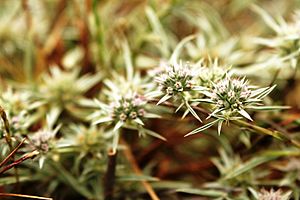Eryngium pendletonense facts for kids
Quick facts for kids Eryngium pendletonense |
|
|---|---|
 |
|
| Conservation status | |
| Scientific classification | |
| Genus: |
Eryngium
|
| Species: |
pendletonense
|
The Pendleton button-celery (scientific name: Eryngium pendletonense) is a very special and rare flowering plant. It belongs to the carrot family, just like the carrots you eat! This plant is only found in a small area of northern San Diego County, California. It grows along the coastline, from Oceanside up to the border of Orange County. Some of these plants even live on Camp Pendleton.
This plant likes to grow in damp grasslands and coastal sage scrub areas. These places have special clay soils that get wet in spring. Scientists first officially described this plant as a new species in 1999.
Contents
What Does It Look Like?
The Pendleton button-celery is a short plant that lives for many years. It's a type of herb, which means it has soft stems, not woody ones like a tree.
Stems and Leaves
The plant has stems that spread out, growing up to 20 centimeters (about 8 inches) long. At the bottom of the plant, it has a group of leaves that form a circle, like a rose. These leaves are long and thin. They have sharp, pointed parts that stick out almost sideways. The leaves can grow quite long, up to 25 centimeters (about 10 inches) from the base of the plant.
Growing Together
Sometimes, several Pendleton button-celery plants grow so close together that they look like one big plant. This is called growing in a "colony."
Flowers and Bracts
The plant produces groups of small flowers. Each group can have up to 19 tiny flowers. These flowers are white and very small, about 1 millimeter long. Around the base of the flowers, there are sharp, triangle-shaped or spear-shaped leaves called bracts. These bracts are a bit bigger than the flower petals.
Why Is It Rare?
The Pendleton button-celery is a very rare plant, and it faces several challenges that make it hard for it to survive.
Threats to Its Home
One big problem is that other plant species, which are not native to California, are growing in its habitat. These "introduced plants" can take over the space and resources that the Pendleton button-celery needs.
Water Changes
Another threat comes from changes in how water flows in its habitat. The plant needs specific wet conditions in spring. If the way water moves through the soil changes, it can harm the plant.
Military Activity
Since some of these plants live on Camp Pendleton, military activities can also affect their habitat. It's important to find ways for the military to train while also protecting this special plant.


